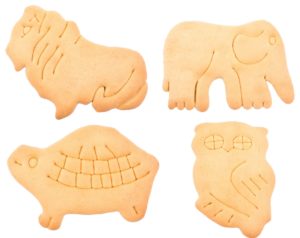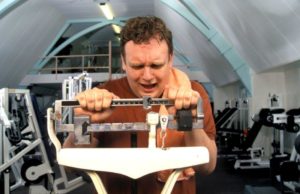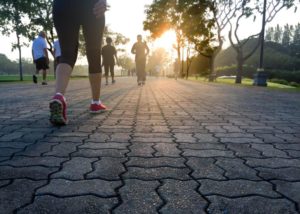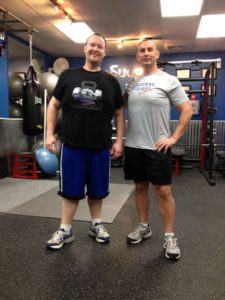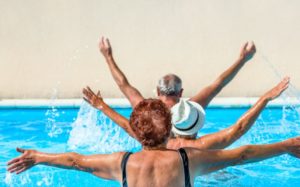Eating for Weight Control
Fitter Kids Have More Brain Gray Matter
While much research has pointed to a relationship between kids’ fitness and academic performance, we now have a new piece of the puzzle: A recent study found that aerobic fitness and speed–agility levels among overweight and obese children aged 8–11 were independently associated with more gray matter in parts of the brain related to better academic performance.
The Federal Government Keeps Making Nutrition Headlines
The current administration appears determined to weaken federal nutrition policy:
Face the Fats
For years, fat was demonized as dietary “Public Enemy Number One.” Despite the essential roles it plays in the body, including temperature regulation, hormone production and protection of organs, we were told it was also responsible for weight gain and a host of health woes. As a result, the public shied away from the macronutrient and instead stocked their kitchens with skim milk, fat-free snacks and low-fat dressings. This approach backfired spectacularly.
MyPlate Goes Seasonal
Looking for new nutrition tools and resources to share with clients? MyPlate has launched seasonal resources for nutrition and health professionals to share with clients. Jump into spring with gardening resources and ideas for using homegrown herbs in cooking, and sample Earth Day activities, farmers’ market resources, and tips for prepping potlucks and parties.
Learn more at choosemyplate.gov/seasonal.
Understanding Set-Point Weight
Humans are hardwired to resist dietary restrictions. Science bears this out: In the absence of an ongoing weight maintenance program, half of the people who lose 10% or more of body weight gain it all back within 5 years or so (Montesi et al. 2016).
On This Day in Fitness History
In February 2009, the American College of Sports Medicine, responding to mounting research evidence, updated its 2001 position stand on how much physical activity is needed to lose weight and not regain it.
Strength Training and Type 2 Diabetes
A regular exercise program can help people with type 2 diabetes to manage blood sugar levels and maintain or improve fitness levels and overall health.
Combined Training for Fitness and Weight Loss Clients
In today’s marketplace, knowing how to offer combined training is a must-have skill. People want it all—cardiovascular, strength and flexibility training—in just 50 minutes.
Taking the Right Step—Walking Research for the Ages
Have you ever heard clients say that “walking doesn’t count” as exercise? The truth is that walking can be a valuable part of your clients’ wellness routines—but how those steps fit into a whole program may depend on age. Two different studies offer valuable feedback on the benefits of walking through a workout.
STUDY #1: When Walking and Weight Loss Are in Step
Lose Weight, Save Money
A new report from Johns Hopkins Bloomberg School of Public Health suggests
that people who are overweight or obese could potentially trade weight for cash.
Authors of the report produced a model linking body mass index, health outcomes and associated costs at various points in an adult’s life. For example, for a 40-year-old, having obesity (vs. normal weight) adds $15,024 in lifetime third-party payer costs, $16,400 in lifetime productivity losses and $31,447 in societal costs. For a person of that age, being overweight (vs.
Some Cancers Are a Weighty Issue
About 40% of cancer cases are related to overweight and obesity, according to a new report from the Centers for Disease Control and Prevention.
Get Up, Stand Up—For Your Health
We know that sitting long hours is a health hazard that can lead to early death. What’s been unclear is whether frequent breaks in sit time can reduce that risk even if total sit time remains the same. Researchers from Columbia University Medical Center looked into that question.
Weight Disparities in Children Worldwide
When it comes to childhood health, lots of emphasis is placed on the risks of being overweight or obese—and an estimated 124 million kids worldwide were in those weight categories in 2016, a tenfold increase since 1975. While this is of great concern, a new study has found that in the same year, 192 million boys and girls were moderately or severely underweight. The researchers believe that family income levels may play a role in a child’s weight.
New Way to Calculate Childhood Obesity
Over the years, experts have questioned the accuracy of body mass index scores, known as BMI “z-scores,” for estimating body fat percentages in kids (the z is specific to younger age groups and requires complicated calculations to get results). The criticism is that adolescent weight doesn’t scale with height, which can produce faulty data. Now, researchers claim to have discovered a new, more accurate formula for measuring body fat in kids aged 8–17.
TV Time a Threat to Mobility in Older Adults
To minimize their future immobility risk, older adults should cut television time and boost activity levels, says new research.
Scientists looked at data on 134,269 subjects aged 50–71 from six states over 8 years. The data included self-reported total sitting time, television viewing time and physical activity intensity, as well as health histories. At follow-up, study participants provided information on walking pace and mobility, indicating whether they were “unable to walk” or could keep up an “easy walking pace.”
A Weigh-In a Day Keeps the Pounds Away?
Stepping on the scale daily may help women lose weight, according to a
new study. For 2 years, at intervals, 294 college-age women provided information on their self-weighing practices and underwent body mass index and body fat testing. According to the data, women who weighed themselves daily saw significant decreases in BMI and body fat percentage over time.
New Dangers Associated With Childhood Obesity
Having obesity as a kid doesn’t just create immediate risks. According to a new study, it may also set the stage for significant health problems later on.
While being obese in childhood is known to predict adulthood obesity, the study’s purpose was to learn about other potential and undetermined weight-related health risks that might take root in the early years. Specifically, the researchers focused on how childhood obesity related to cardiovascular disease and abnormal blood sugar levels that result in disease.
Weight Loss and the Resistant Client
client: Paul | personal trainer: Joe Carson, Wellness Coordinator, Spann Wellness Center | location: Tulsa, Oklahoma
The power of fear. It was early morning, and personal trainer Joe Carson had instructed his client, Paul, to complete a progressive-load “up-down” circuit that included a lat pull-down. The two had worked together for some time, so Carson knew that Paul was strong enough to finish.
Water-Based Weight Loss Programs Help Older Women Manage Knee Problems
Ratcheting up the intensity of water workouts may help women lose weight without exacerbating knee pain, suggests a new study. Knee osteoarthritis (OA) affects around 13% of women aged 60 and older, and the condition can make it painful for them to exercise and lose weight. It can also become a Catch-22, because carrying excess weight can worsen the problem.
Is Exercise an Ineffective Tool for Weight Management?
Being physically active is a primary way to lose or manage weight—right? And sedentary behavior is largely to blame for
current rates of obesity? Well, let's slow down. Findings from
a study conducted at Loyola University Chicago challenge both those statements.

